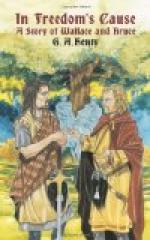Bruce’s conduct to his prisoners was even more honourable to himself than was the great victory that he had won. In spite of his three brothers, his brother in law Seaton, his friends Athole and Frazer, having been executed by the English, and the knowledge that their mangled remains were still exposed over London Bridge and the gates of Carlisle and Newcastle — in spite of the barbarous and lengthened captivity of his wife, his sister and daughter, and his friend the Countess of Buchan — in spite of the conviction that had he himself been made prisoner he would at once have been sent to the scaffold — Bruce behaved with a magnanimity and generosity of the highest kind. Every honour was paid to the English dead, and the bodies of the chief among these were sent to their relatives in England, and the prisoners were all either ransomed or exchanged. Sir Marmaduke de Twenge was dismissed free of ransom and loaded with gifts, and even the Scotch nobles, such as Sir Philip Mowbray, who were taken fighting in the ranks of their country’s enemy, were forgiven. This noble example exercised but little influence upon the English. When Edward Bruce was killed four years afterwards at Dundalk in Ireland, his body was quartered and distributed, and his head presented to the English king, who bestowed upon Birmingham — who commanded the English and sent the gift to him — the dignity of Earl of Louth.
Among the prisoners was Edward’s poet laureate, Baston, a Carmelite friar, who had accompanied the army for the purpose of writing a poem on the English victory. His ransom was fixed at a poem on the Scotch victory at Bannockburn, which the friar was forced to supply.
With Bannockburn ended all hope on the part of the English of subjugating Scotland; but the war continued fitfully for fourteen years, the Scotch frequently invading England and levying heavy contributions from the northern counties and towns, and the English occasionally retaliating by the same process; but at length peace was signed at Northampton.
In 1315 a parliament assembled at Ayr for the purpose of regulating the succession to the throne. It was then agreed that in case of the king’s death without male issue his brother Edward should succeed to it, and that if Edward left no heirs, the children of Marjory, the king’s daughter, should succeed. Shortly afterwards Marjory was married to Walter the Steward. Edward Bruce was killed unmarried. A son was afterwards born to the king, who reigned as David II, but having died without issue, the son of Marjory and the Steward became king. The hereditary title of Steward was used as the surname for the family, and thus from them descended the royal line of Stewart or Stuart, through which Queen Victoria at present reigns over Great Britain, Ireland, and their vast dependencies.
After Bannockburn Archie Forbes went no more to the wars. He was raised to the dignity of Baron Forbes by the king, and was ever rewarded by him as one of his most trusty councillors, and his descendants played a prominent part in the changing and eventful history of Scotland; but the proudest tradition of the family was that their ancestor had fought as a patriot by the side of Bruce and Wallace when scarce a noble of Scotland but was leagued with the English oppressors of their country.




